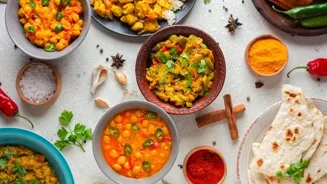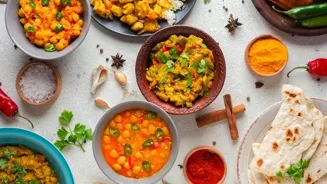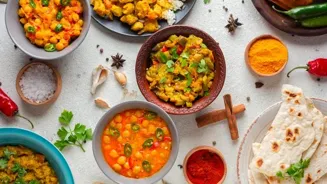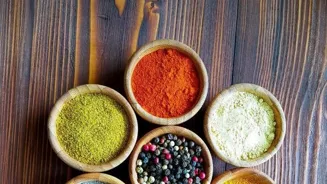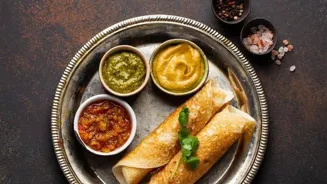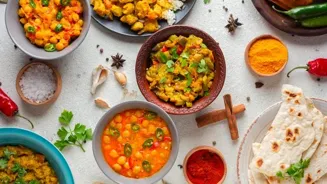Embark on a culinary journey through time with 10 iconic Indian dishes & their fascinating origins. Dive deeper to discover more!
India, a land famed for its vibrant culture and diverse traditions, is also
a treasure trove of mouthwatering cuisine. Each dish tells a story, reflecting the region's history, climate, and available ingredients.
Let's embark on a delightful journey to discover the origins of 10 iconic Indian vegetarian dishes that have tantalized taste buds for generations.
Samosa: From the Middle East to Indian Streets
Our culinary adventure starts with the beloved samosa. While readily available at every corner in India, its roots lie far beyond our borders.
The samosa's ancestor, the 'sambusak,' originated in the Middle East, making its way to India with traders and travelers during the Delhi Sultanate period, around the 13th or 14th century.
Initially, the samosa was made with meat fillings, but over time, the Indian version evolved, embracing potatoes and peas as the primary ingredients. Today, the samosa is a quintessential Indian snack, enjoyed with chutneys and chai, a testament to the fusion of cultures and flavors.
Idli: A South Indian Staple with Indonesian Connections
The humble idli, a steamed rice cake, is a South Indian breakfast staple, a simple yet satisfying dish. Interestingly, some historians believe that the idli bears resemblance to dishes from Indonesia, specifically the 'kedli.
' They argue that it was likely introduced to India by cooks accompanying Hindu kings of the Sailendra dynasty who were in close contact with South India.
Early forms of idli were perhaps coarser, but with time and culinary innovation, the idli transformed into the soft, fluffy delight we savor today. The fermentation process, essential to idli, creates the digestive-friendly dish.
Dosa: A Tale of Accidental Fermentation
The crispy, golden crepe known as the dosa is another popular South Indian treasure. Legend has it that the dosa came about by sheer accident, due to excess fermentation of a batter when rice and lentils were ground and combined. The accidental fermentation later led to an innovation.
This happened when people tried a different type of batter, which resulted into a crispy Dosa. The dish subsequently became a beloved breakfast option for many. The dosa is incredibly versatile; it can be filled with potatoes to make masala dosa, or enjoyed plain with sambhar and chutney.
Rajma Chawal: A Punjabi Heartthrob with Mexican Roots
Rajma chawal, a comforting combination of kidney bean curry and rice, is a North Indian favorite, particularly in Punjab. It is believed that the kidney bean, or 'rajma,' was originally brought to India from Mexico, South America.
Over a period of time, the locals of Punjab began to cultivate rajma, adapting their cooking styles to create the rich, creamy curry it is today, pairing it with rice for a wholesome and satisfying meal. Rajma chawal is not just food, it's an emotion, evoking feelings of warmth and nostalgia.
Chole Bhature: A Culinary Gift from Punjab
Chole bhature, a delightful combination of spicy chickpea curry and fried bread, is another culinary gem from Punjab. While the exact history is hazy, many culinary experts believe that chole bhature emerged as a substantial dish in the 20th century.
The rich and flavorful chole, prepared using locally sourced chickpeas and a blend of aromatic spices, perfectly complements the fluffy bhature, creating a hearty and satisfying meal that is popular across India. It is often found in street food in most of the cities like Delhi, Gurgaon.
Vada Pav: Mumbai's Iconic Street Food Creation
Vada pav, often hailed as India's take on a "burger", originated in Mumbai in the 1960s. Ashok Vaidya, a street vendor, combined the Maharashtrian vada(potato fritter) with the pav(bread).
The vada pav was not only easily affordable, but also provided sustenance to the mill workers and laborers of Mumbai. The popularity of vada pav grew rapidly, becoming the ultimate street food snack, representing the city's fast-paced lifestyle and its love for flavorful, inexpensive eats.
It is garnished with chutneys and fried chili.
Dhokla: A Gujarati Delight with Ancient Origins
Dhokla, a steamed, spongy snack made from fermented batter, originates from Gujarat, India. Records show that dhokla's origins may be dating to the 11th or 12th century, the dish found mentions in ancient texts indicating a form of dhokla existed in that era.
However, the modern dhokla that we are familiar with today mostly developed in the later years. It is seasoned which makes the texture different, garnished with mustard seeds and cilantro. Dhokla is a healthy option, and a popular tea-time snack enjoyed with chutney.
Litti Chokha
The state of Bihar owes the country a snack that could be the best representation of authentic flavours. Litti Chokha is a dish that is as traditional as it gets. Litti is the dough balls that are mostly made of wheat & stuffed with fillings of gram flour, spices and herbs.
Traditionally, it is baked over charcoal, but these can also be baked in an oven or fried. Chokha is mixture of boiled and mashed potatoes mixed with eggplant and tomatoes. The whole combination is seasoned with spices and herbs.
Poha
One of the most popular breakfast option, the light delight from Maharashtra, that eventually migrated to Madhya Pradesh, now found in almost every Indian household. Made from flattened rice, the way it is seasoned varies from region to region.
Lightly fried with onions, mustard seeds and curry leaves, this snack is easy to digest and one of the most preferred breakfast options.
Pongal
From the South of India, we have pongal, a dish made of rice and lentils. These two things are then boiled together in a pot or pressure cooker. There are two versions to it, one being sweet and the other being spicy. It is made during Makar Sankranti and is one of the most important dishes here.
These ten iconic vegetarian dishes represent only a tiny fraction of India's vast and diverse culinary landscape. Each dish has a unique story to tell, reflecting the country's rich history, cultural exchange, and culinary innovation.
So, the next time you savor these dishes, remember the journey they have undertaken to reach your plate, and appreciate the beautiful tapestry of flavors that is Indian cuisine.
AI Generated Content. Glance/InMobi shall have no liability for the content